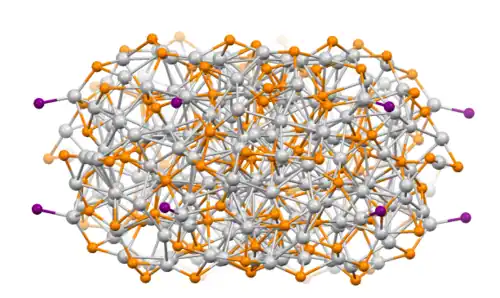Bis(trimethylsilyl)sulfide
2.svg.png) | |||
| |||
| Names | |||
|---|---|---|---|
| Preferred IUPAC name Hexamethyldisilathiane | |||
| Other names Trimethyl[(trimethylsilyl)sulfanyl]silane | |||
| Identifiers | |||
3D model (JSmol) | |||
| 1698358 | |||
| ChemSpider | |||
| ECHA InfoCard | 100.020.184 | ||
| EC Number |
| ||
PubChem CID | |||
| UNII | |||
| UN number | 1993 | ||
CompTox Dashboard (EPA) | |||
| |||
| |||
| Properties | |||
| C6H18SSi2 | |||
| Molar mass | 178.44 g·mol−1 | ||
| Appearance | colourless liquid with foul odor | ||
| Density | 0.846 g cm−3 | ||
| Boiling point | 163 °C (325 °F; 436 K) | ||
| hydrolyzes | |||
| Solubility in other solvents | ethers such as THF and arenes such as toluene [1] | ||
Refractive index (nD) | 1.4586 | ||
| Structure | |||
| 1.85 D | |||
| Hazards | |||
| Occupational safety and health (OHS/OSH): | |||
Main hazards | Toxic | ||
| GHS labelling: | |||
  | |||
| Danger | |||
| H226, H301, H311, H331[2] | |||
| P261, P280, P301+P310, P311[2] | |||
| NFPA 704 (fire diamond) | |||
| Safety data sheet (SDS) | "External MSDS" | ||
| Related compounds | |||
Related compounds | B2S3, SiS2 | ||
Except where otherwise noted, data are given for materials in their standard state (at 25 °C [77 °F], 100 kPa). Infobox references | |||
Bis(trimethylsilyl) sulfide is the chemical compound with the formula ((CH3)3Si)2S. Often abbreviated (tms)2S, this colourless, vile-smelling liquid is a useful aprotic source of "S2−" in chemical synthesis.[3]
Synthesis
The reagent is prepared by treating trimethylsilyl chloride with anhydrous sodium sulfide:[4]
- 2 (CH3)3SiCl + Na2S → ((CH3)3Si)2S + 2 NaCl
((CH3)3Si)2S must be protected from air because it hydrolyzes readily:
- ((CH3)3Si)2S + H2O → ((CH3)3Si)2O + H2S
Use in synthesis
Bis(trimethylsilyl)sulfide is a reagent for the conversion of metal oxides and chlorides into the corresponding sulfides.[5] This transformation exploits the affinity of silicon(IV) for oxygen and halides. An idealized reaction is:
- ((CH3)3Si)2S + MO → ((CH3)3Si)2O + MS
In a similar way, it has been used in the conversion of aldehydes and ketones to the corresponding thiones.[6][7]

Safety
((CH3)3Si)2S reacts exothermically with water, releasing toxic H2S.
References
- ^ mastersearch.chemexper.com/cheminfo/servlet/org.dbcreator.MainServlet
- ^ a b Product catalog sigmaaldrich.com
- ^ Matulenko, M. A. (2004). "Bis(trimethylsilyl) Sulfide". Encyclopedia of Reagents for Organic Synthesis. Vol. 1. p. 5. doi:10.1002/047084289X. hdl:10261/236866. ISBN 9780471936237.
- ^ So, J.-H.; Boudjouk, P. (1992). "Hexamethyldisilathiane". In Russell, N. G. (ed.). Inorganic Syntheses. Vol. 29. New York: Wiley. p. 30. doi:10.1002/9780470132609.ch11. ISBN 0-471-54470-1.
- ^ Lee, S. C.; Holm, R. H., "Nonmolecular Metal Chalcogenide/Halide Solids and Their Molecular Cluster Analogues", Angewandte Chemie International Edition in English, 1990, volume 29, pages 840-856.
- ^ A. Capperucci; A. Degl'Innocenti; P. Scafato; P. Spagnolo (1995). "Synthetic Applications of Bis(trimethylsilyl)sulfide: Part II. Synthesis of Aromatic and Heteroaromatic o-Azido-Thioaldehydes". Chemistry Letters. 24 (2): 147. doi:10.1246/cl.1995.147.
- ^ W. M. McGregor; D. C. Sherrington (1993). "Some Recent Synthetic Routes to Thioketones and Thioaldehydes". Chemical Society Reviews. 22 (3): 199–204. doi:10.1039/CS9932200199.
- ^ Fenske, D.; Persau, C.; Dehnen, S.; Anson, C. E. (2004). "Syntheses and Crystal Structures of the Ag-S Cluster Compounds [Ag70S20(SPh)28(dppm)10] (CF3CO2)2 and [Ag262S100(St-Bu)62(dppb)6]". Angewandte Chemie International Edition. 43 (3): 305–309. doi:10.1002/anie.200352351. PMID 14705083.
sulfide-3D-balls.png)
sulfide-3D-spacefill.png)
